[Note: A version of this article appeared in The Morris Dancer, 3.11 (December 2003), 331-44. Unfortunately, essential pieces of text were omitted and the pictures were transposed from their intended positions, making it very difficult to interpret the published text. In the version below the pictures are restored to their correct positions and the text is complete.]
Some of the earliest references to morris dances and dancers occur in inventories of goods. Two different wills proved in 1458 refer to ornamental vessels with depictions of morris dancers on them, and a tapestry listed as being in Caistor Castle in 1448 also had morris dancers on it. None of these goods survives, so we can only speculate on their appearance.![]() 1
1
Three sets of images which do survive appear to be related and perhaps can give some insight into the ways in which images of 'morris' were transmitted in the fifteenth and sixteenth centuries. All of them are well known, but the exact nature and the closeness of their relationship is not always recognised. Moreover, comparisons tend to be made at the level of the entire image, not at the level of the individual images within them.
The three images are: the copperplate engraving by Israhel van Meckenem from about 1490; the Betley window; and the carved morris dance panel from Lancaster castle, probably early to mid sixteenth century. It's perhaps especially fitting to consider these now, as van Meckenem died exactly five hundred years ago, on 10 November 1503.
The first of these, van Meckenem's print, was reproduced as long ago as 1808 by Francis Douce in his Dissertation on the Ancient English Morris Dance.![]() 2 He compared it with (and also reproduced a picture of) the Betley window. The Betley window has been discussed several times, most authoritatively by E J Nicol in 'Some Notes on the History of the Betley Window' in 1953
2 He compared it with (and also reproduced a picture of) the Betley window. The Betley window has been discussed several times, most authoritatively by E J Nicol in 'Some Notes on the History of the Betley Window' in 1953![]() 3 and by Godfrey Brown in This Old House (a description of Betley Court) in 1987.
3 and by Godfrey Brown in This Old House (a description of Betley Court) in 1987.![]() 4 The Lancaster Castle panel was described by Anne Gilchrist in 'A Carved Morris Dance Panel from Lancaster Castle' in 1933
4 The Lancaster Castle panel was described by Anne Gilchrist in 'A Carved Morris Dance Panel from Lancaster Castle' in 1933![]() 5, and she mentions the similarities to both Meckenem's print and the Betley window images, without apparently realising that they are not just similar, but that the two last are to a significant degree copies from the first. Douce realised, and Nicol concurs, that the Betley window is based on Meckenem. Although Nicol alludes to Gilchrist's description of the Lancaster Castle panel, it seems that he too failed to realise that it is yet another derivative copy.
5, and she mentions the similarities to both Meckenem's print and the Betley window images, without apparently realising that they are not just similar, but that the two last are to a significant degree copies from the first. Douce realised, and Nicol concurs, that the Betley window is based on Meckenem. Although Nicol alludes to Gilchrist's description of the Lancaster Castle panel, it seems that he too failed to realise that it is yet another derivative copy.
A very good website drawing together many of these threads can be found among the web pages of St Albans Morris Men.![]() 6
6
It should be noted that the description of these dancers as 'morris dancers' is in every case the result of later antiquarian interpretation, and is not from contemporary sources.
It's best to start with van Meckenem's print. Van Meckenem was a goldsmith and copper engraver from Bocholt in Westphalia. It is thought that his primary occupation was as a goldsmith, and that at least some of his engravings arose in the course of his goldsmith's work. It has been surmised that our engraving was intended as the basis for a design for a piece of gold ware.![]() 7
7

Over five hundred engravings and works by van Meckenem are known, most of them religious in character. One is a roundel called 'Moriskentanz', but this has nothing to do with our engraving. Although the engraving reproduced here is frequently referred to as depicting a morris dance, in the fullest catalogue of van Meckenem's work![]() 8 it is described as 'Querfüllung mit dem Tanz der Verliebten' ['Panel with the Dance of the Lovers']. Several examples of prints from the engraving are known, scattered throughout Europe. There are examples in Cambridge, London and Oxford, and it is clear that it had some currency in artistic circles.
8 it is described as 'Querfüllung mit dem Tanz der Verliebten' ['Panel with the Dance of the Lovers']. Several examples of prints from the engraving are known, scattered throughout Europe. There are examples in Cambridge, London and Oxford, and it is clear that it had some currency in artistic circles.
On stylistic grounds the engraving is confidently dated to the 1490s. It was much copied, and in some copies the figures are reversed left-right.
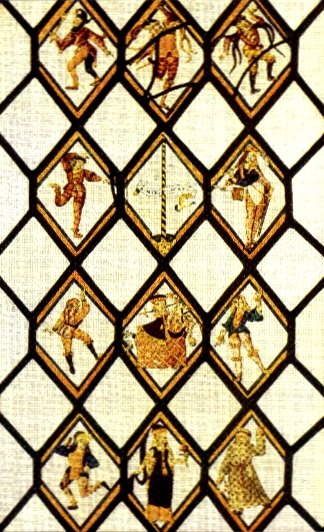 The Betley Window
The Betley WindowThe date and creator of the Betley window (now in the Victoria and Albert Museum) are unknown. Godfrey Brown suggests a date as early as 1509; an occasion, the marriage of Henry VIII; and a place, London (with the window only later bring taken to Staffordshire).
The use of enamel - especially blue - suggests a rather later date, not earlier than around the middle of the sixteenth century, and possibly some Flemish involvement. The window is certainly English (the words 'A Mery May' in the middle pane establish this beyond reasonable doubt), but the use of advanced technology for the day and perhaps a foreign craftsman do indicate a metropolitan origin in the capital, and make it more likely that the creator would have had access to images such as van Meckenem's as a model. (An even later date, in the early seventeenth century, has also been suggested, but this seems at odds with the sentiments expressed by the iconography and raises the question of how the image resurfaced over a century after its creation.)
The fact that the characters in the Betley window are modelled on van Meckenem's is well established. The figures in the window are reversed, so it presumably derives from one of the reversed copies of the original print. I have not seen in print a figure-by-figure comparison of the dancers, however, so one is given below.
To avoid ambiguity, and as far as possible to avoid the use of names attributing characteristics to the figures, in the discussion below the figures are identified as follows. In van Meckenem's print and the Lancaster Castle panel the figures are numbered left to right. In the Betley window they are numbered left to right, top to bottom. In all the comparisons with other images, the Betley images are presented here left-right reversed.
The corresponding figures from van Meckenem and Betley are juxtaposed below. In most cases the similarities are self-evident.
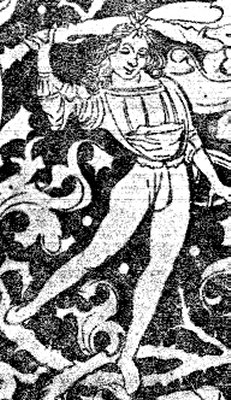

Meckenem 1 and Betley 9

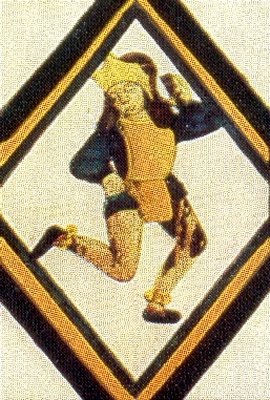
Meckenem 2 and Betley 10

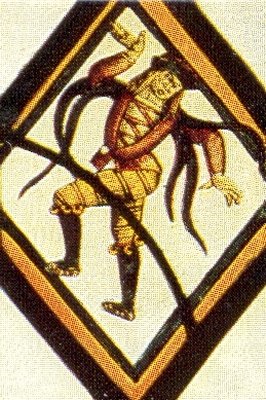
Meckenem 3 and Betley 3
Meckenem 4 is a fool or jester with ass's ears on his hood. He appears to have no derived figure in the Betley window. The figure with fool's cap in the Betley window, Betley 1, is quite different in composition.


Meckenem 4 and Betley 1
Meckenem 5, the central figure of van Meckenem's print is a female, closely matched - even to the design of the dress - in the Betley window figure.


Meckenem 5 and Betley 11

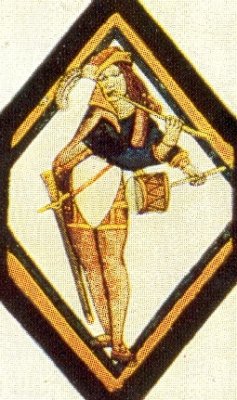
Meckenem 6 and Betley 6
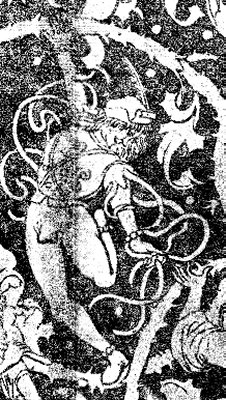

Meckenem 7 and Betley 2


Meckenem 8 and Betley 7
Van Meckenem 9 is a dancer who appears to have no counterpart in Betley.

Meckenem 9
So seven of the nine van Meckenem images have counterparts in the Betley window. There are five more images in the Betley window. We have already noted the figure with a fool's cap, Betley 1. The other four are reproduced below (Betley 4 reversed, to retain comparability with the other images which it resembles; the others are not reversed).


Betley 4 and Betley 5


Betley 8 and Betley 12
Betley 5,8 and 12 appear to represent very English concepts; Betley 5 has the English phrase 'A Mery May' in front of what appears to be a maypole; Betley 8 is a hobby horse; and Betley 12 a friar. Contemporary references show these three all have close associations with morris dances in the sixteenth century. It is just possible, perhaps, that the posture of Betley 12, beneath his robes, is based on that of van Meckenem 9 (but if so, is not reversed).
Betley 4 is the only dancing figure which appears to have no counterpart in the van Meckenem print. It bears a resemblance to Betley 2, with the top half again left-right reversed so that it matches the van Meckenem orientation. The raised arm in Betley 2 is more crooked than is its counterpart in van Meckenem 7, and the arm in Betley 4 yet more crooked than is the arm in Betley 2.
The links between the van Meckenem and Betley images are well known and I have done little more than rehearse the observations of previous writers from Francis Douce onwards. The antecedents of the Lancaster Castle panel have not been so thoroughly discussed. In examining the Lancaster Castle panel it became clear to me that, just as the Betley images can be shown to derive from van Meckenem, so the Lancaster images can be shown to derive from van Meckenem and Betley.

According to Gilchrist, the Lancaster Castle panel is difficult to date and only 'sixteenth century' has been suggested. The Castle was refurbished by Queen Elizabeth about 1580.
The first of the seven Lancaster images is the only one without a direct counterpart in Betley. It shows a figure in a skirt but bears absolutely no resemblance to the female figure in van Meckenem 5/Betley 11.

The other Lancaster images all have direct counterparts in Betley:


Lancaster 2 and Betley 6


Lancaster 3 and Betley 10
Although the posture of Lancaster 3 is the same as that of Betley 10 (and of van Meckenem 2) the character appears quite different; Gilchrist calls it a representation of a naked female, and alludes to naked figures (sometimes representing Adam and Eve) in contemporary English pageants.


Lancaster 4 and Betley 4


Lancaster 5 and Betley 2


Lancaster 6 and Betley 3


Lancaster 7 and Betley 1
The overall table of comparisons looks like this:
| Comparison of images | ||
|---|---|---|
| Van Meckenem 1 | Betley 9 | |
| Van Meckenem 2 | Betley 10 | Lancaster 3 |
| Van Meckenem 3 | Betley 3 | Lancaster 6 |
| Van Meckenem 4 | (cf. Betley 1) | |
| Van Meckenem 5 | Betley 11 | (cf. Lancaster 1) |
| Van Meckenem 6 | Betley 6 | Lancaster 2 |
| Van Meckenem 7 | Betley 2 | Lancaster 5 |
| Van Meckenem 8 | Betley 7 | |
| Van Meckenem 9 | ||
| Betley 1 | Lancaster 7 | |
| Betley 4 | Lancaster 4 | |
| Betley 5 | ||
| Betley 8 | ||
| Betley 12 | ||
| Lancaster 1 | ||
In each of the series the costumes of the characters have been adapted, but in most cases retain points of similarity with their precursors. For example, the musician Van Meckenem 6/Betley 6/Lancaster 2 has a feather curling to the left from his cap. The feather is almost identical in the van Meckenem and Betley images, while in the Lancaster image it dangles from the cap rather than curves away from it. In this respect, and with regard to the iconography generally, Betley is more conservative than Lancaster. The costumes of the characteristically English images in Betley do have less in common with those in van Meckenem, but the one additional dancer, Betley 4, has a costume which seems to belong with that of the characters derived from van Meckenem. The character at Betley 1, also (who resembles a fool, with cap and bells and coxcomb), has a costume similar to that of the other dancers. This may imply that these two derive from some intermediate print closely based on van Meckenem but containing such images.
The images that link Betley with Lancaster may have greater significance. There are two pairs - Betley 1/Lancaster 7 and Betley 4/Lancaster 4 - which are absent from van Meckenem. This means either that one of Betley and Lancaster is the source for the other, or that they both derive from a source intermediate between them and van Meckenem, which contained both figures. The fact that Lancaster retains the original orientation, while Betley does not, gives credibility to the latter hypothesis.
The relationship suggested by these considerations can be represented as below, in which each figure is named from its earliest appearance.
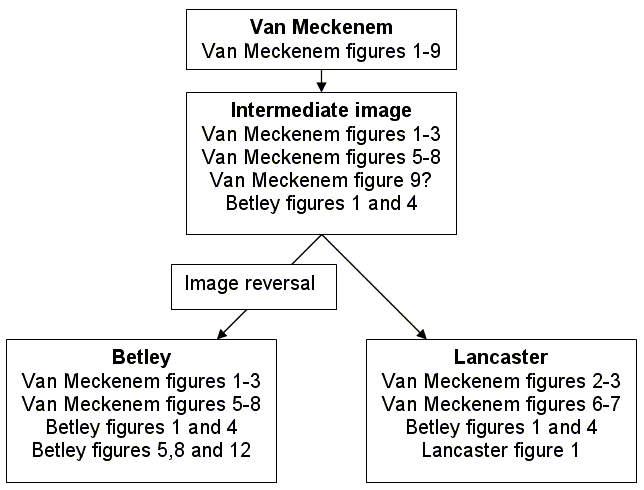
The degree of modification of the costumes in the Lancaster figures may suggest that at least one more intermediate image may interpose between the one we have postulated and the Lancaster panel itself. I am not an iconographer and have not attempted to search the print and image libraries of Britain or Europe for such images. Such an image containing the antecedents of Betley 1 and Betley 4, before reversal, may well exist, and if so it is very likely to be the source of the English images.
Mike Heaney - 13.3.04
Article MT138
| Top | Home Page | MT Records | Articles | Reviews | News | Editorial | Map |